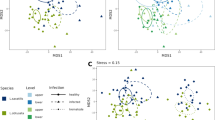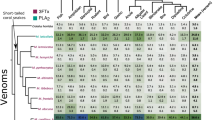Abstract
The venom gland of workers of Pachycondyla (= Neoponera) apicalis (Hymenoptera: Formicidae) contains the bitter-tasting cyclic dipeptide of leucine and phenylalanine [cyclo-leu-phe or 3-benzyl-6-(2-methylpropyl)-2,5-piperazinedione]. The venom also contains proteins of undetermined activity. It is suggested that the function of the venom may be both defensive and offensive. The mandibular glands of N. apicalis contains δ-decalactone and benzaldehyde.
Similar content being viewed by others
REFERENCES
ATTYGALLE, A. B., and MORGAN, E. D. 1983. Reaction gas chromatography without solvent for identification of nanogram quantities of natural products. Anal. Chem. 55:1379–1384.
ATTYGALLE, A. B., and MORGAN, E. D. 1984. Chemicals from the glands of ants. Chem. Soc. Rev. 13:245–278.
BAGNÈRES, A. G., and MORGAN, E. D. 1990. A simple method for analysis of insect cuticular hydrocarbons. J. Chem. Ecol. 16:3263–3276.
BLUM, M. S. 1981. Chemical Defenses of Arthropods. Academic Press, New York, pp. 239–246.
BLUM, M. S., PADOVANI, F., CURLEY, A., and HAWK, R. E. 1969. Releasers of social behaviour XIV. Benzaldehyde defensive secretion of harvester ant. Comp. Biochem. Physiol. 29:461–465.
ERSPAMER, V., FALCONIERI ERSPAMER, G., and CEI, J. M. 1986. Active peptides in the skins of two hundred and thirty American amphibian species. Comp. Biochem. Physiol. C: Comp. Pharmacol. Toxicol. 85C:125–137.
GARDNER, R. J. 1980. Correlation between bitterness thresholds of amino acids and peptides with molecular connectivity. J. Sci. Food Agric. 31(1):23–30.
HEYNS, K., and GRÜTZMACHER, H. F. 1966. Massenspektrometrische analysen von aminosäuren und peptiden. Fortschr. Chem. Forsch. 6(4):536–581.
JOHNSTONE, R. A. W., and POVALL, T. J. 1975. Methods of peptide sequencing 1. Conversion of oligopeptides into cyclic dipeptides. Gas chromatographic-mass spectrometric study. J. Chem. Soc. Perkin Trans. 1:1297–1300.
KELLEY, C., and BROWN, R. 1966. The production of leucylphenylalanine anhydride by a variant of Streptomyces noursei. Experientia, 22:721–722.
LELUK, J., SCHMIDT, J., and JONES, D. 1989. Comparative studies of the protein composition of hymenopteran venom reservoirs. Toxicon 27:105–114.
LUBY, J. M., REGNIER, F. E., CLARKE, E. T., WEAVER, E. C., and WEAVER, N. 1973. Volatile cephalic substances of the stingless bees Trigona mexicana and Trigona pectoralis. J. Insect Physiol. 19:1111–1127.
MATOBA, T., and HATA, T. 1972. Relationship between bitterness of peptides and their chemical structures. Agric. Biol. Chem. 36(8):1423–1431.
MORGAN, E. D. 1990. Preparation of small scale samples from insects for chromatography. Anal. Chim. Acta 236:227–235.
MORGAN, E. D., and WADHAMS, L. J. 1972. Gas chromatography of volatile compounds in small samples of biological materials. J. Chromatogr. Sci. 10:528–529.
NEY, K. H. 1986. Cocoa flavour—bitter compounds as its essential taste components. Gordian 86:84–88.
PICKENHAGEN, W., DIETRICH, P., KEIL, B., POLONSKY, J., NOUAILLE, F., and LEDERER, E. 1975. Identification of the bitter principle of cocoa. Helv. Chem. Acta 58:1078–1086.
SCHMIDT, J. O. 1986. Chemistry, pharmacology and chemical ecology of ant venoms, pp. 425–508, in T. Piek (ed.). Venoms of the Hymenoptera: Biochemical, Pharmacological and Behavioural Aspects. Academic Press, London.
SHIBA, T., URATANI, H., KUBOTA, I., and SUMI, Y. 1981. Some aspects of the relationship between the structure of a bitter diketopiperazine and its receptor. Biopolymers 20:1985–1987.
SZAFRANEK, J., PALACZ, Z., and GRZONKA, Z. 1976. A comparison of electron impact and field ionization spectra of some 2,5-diketopiperazines. Org. Mass Spectrom. 11(9):920–930.
Rights and permissions
About this article
Cite this article
Lopez, L.C., Morgan, E.D. Explanation of Bitter Taste of Venom of Ponerine Ant, Pachycondyla apicalis . J Chem Ecol 23, 705–712 (1997). https://doi.org/10.1023/B:JOEC.0000006405.26872.ef
Issue Date:
DOI: https://doi.org/10.1023/B:JOEC.0000006405.26872.ef




